2017 NISSAN ROGUE HYBRID navigation system
[x] Cancel search: navigation systemPage 5 of 520
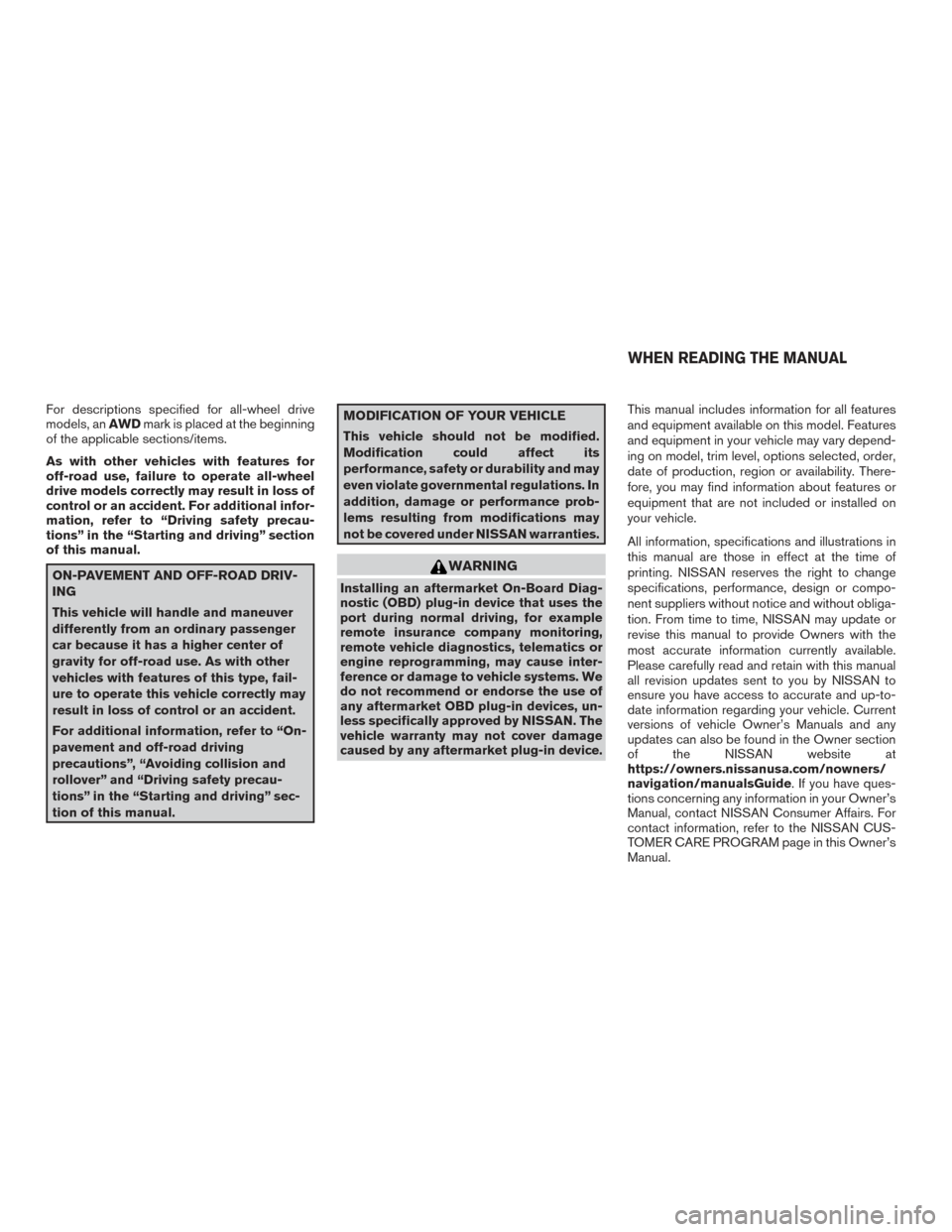
For descriptions specified for all-wheel drive
models, anAWDmark is placed at the beginning
of the applicable sections/items.
As with other vehicles with features for
off-road use, failure to operate all-wheel
drive models correctly may result in loss of
control or an accident. For additional infor-
mation, refer to “Driving safety precau-
tions” in the “Starting and driving” section
of this manual.
ON-PAVEMENT AND OFF-ROAD DRIV-
ING
This vehicle will handle and maneuver
differently from an ordinary passenger
car because it has a higher center of
gravity for off-road use. As with other
vehicles with features of this type, fail-
ure to operate this vehicle correctly may
result in loss of control or an accident.
For additional information, refer to “On-
pavement and off-road driving
precautions”, “Avoiding collision and
rollover” and “Driving safety precau-
tions” in the “Starting and driving” sec-
tion of this manual.
MODIFICATION OF YOUR VEHICLE
This vehicle should not be modified.
Modification could affect its
performance, safety or durability and may
even violate governmental regulations. In
addition, damage or performance prob-
lems resulting from modifications may
not be covered under NISSAN warranties.
WARNING
Installing an aftermarket On-Board Diag-
nostic (OBD) plug-in device that uses the
port during normal driving, for example
remote insurance company monitoring,
remote vehicle diagnostics, telematics or
engine reprogramming, may cause inter-
ference or damage to vehicle systems. We
do not recommend or endorse the use of
any aftermarket OBD plug-in devices, un-
less specifically approved by NISSAN. The
vehicle warranty may not cover damage
caused by any aftermarket plug-in device. This manual includes information for all features
and equipment available on this model. Features
and equipment in your vehicle may vary depend-
ing on model, trim level, options selected, order,
date of production, region or availability. There-
fore, you may find information about features or
equipment that are not included or installed on
your vehicle.
All information, specifications and illustrations in
this manual are those in effect at the time of
printing. NISSAN reserves the right to change
specifications, performance, design or compo-
nent suppliers without notice and without obliga-
tion. From time to time, NISSAN may update or
revise this manual to provide Owners with the
most accurate information currently available.
Please carefully read and retain with this manual
all revision updates sent to you by NISSAN to
ensure you have access to accurate and up-to-
date information regarding your vehicle. Current
versions of vehicle Owner’s Manuals and any
updates can also be found in the Owner section
of the NISSAN website at
https://owners.nissanusa.com/nowners/
navigation/manualsGuide. If you have ques-
tions concerning any information in your Owner’s
Manual, contact NISSAN Consumer Affairs. For
contact information, refer to the NISSAN CUS-
TOMER CARE PROGRAM page in this Owner’s
Manual.
WHEN READING THE MANUAL
Page 12 of 520
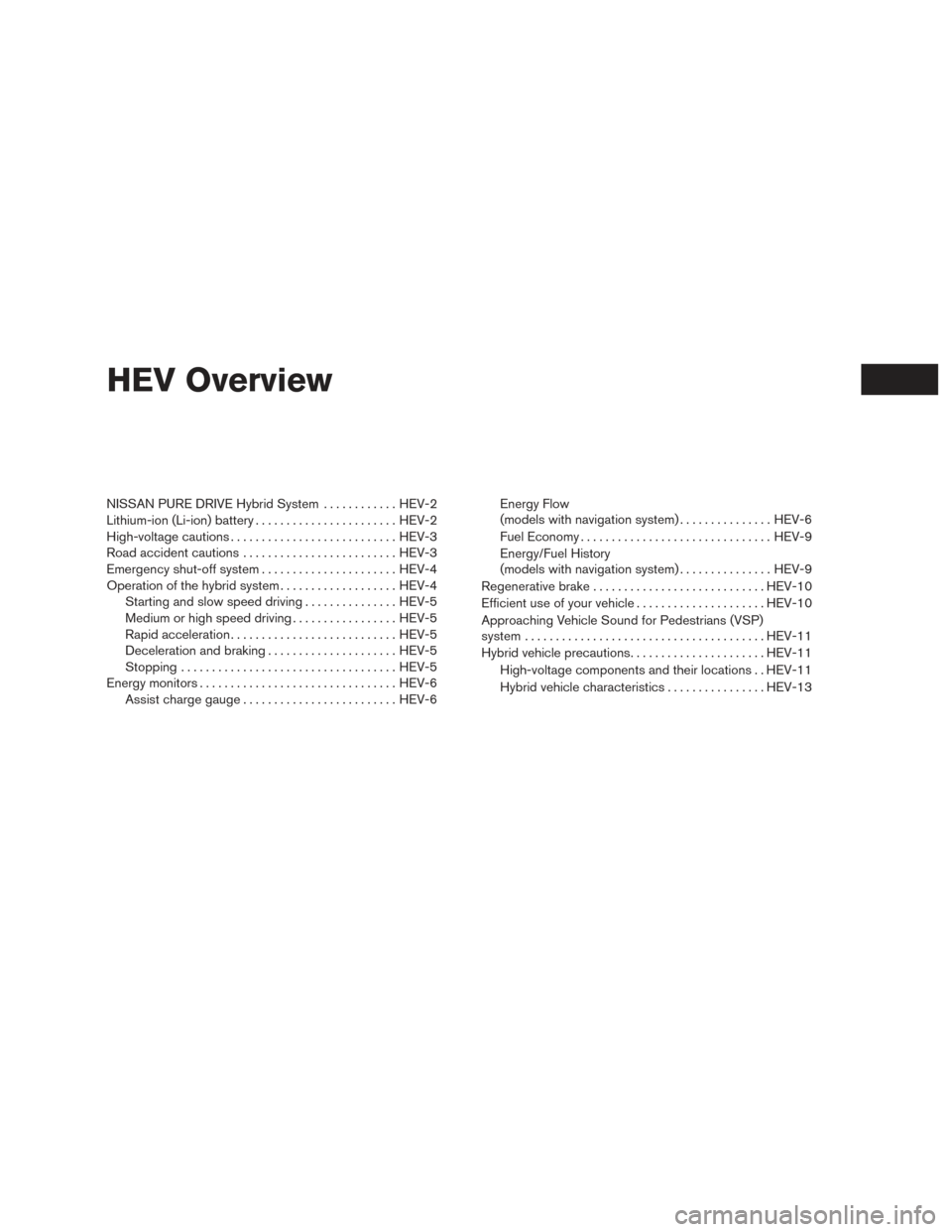
HEV Overview
NISSAN PURE DRIVE Hybrid System............HEV-2
Lithium-ion (Li-ion) battery .......................HEV-2
High-voltage cautions ........................... HEV-3
Road accident cautions ......................... HEV-3
Emergency shut-off system ......................HEV-4
Operation of the hybrid system ...................HEV-4
Starting and slow speed driving ...............HEV-5
Medium or high speed driving . . ...............HEV-5
Rapid acceleration ........................... HEV-5
Deceleration and braking .....................HEV-5
Stopping ................................... HEV-5
Energy monitors ................................ HEV-6
Assist charge gauge ......................... HEV-6Energy Flow
(models with navigation system)
...............HEV-6
Fuel Economy ............................... HEV-9
Energy/Fuel History
(models with navigation system) ...............HEV-9
Regenerative brake ............................ HEV-10
Efficient use of your vehicle .....................HEV-10
Approaching Vehicle Sound for Pedestrians (VSP)
system ....................................... HEV-11
Hybrid vehicle precautions ......................HEV-11
High-voltage components and their locations . . HEV-11
Hybrid vehicle characteristics ................HEV-13
Page 17 of 520
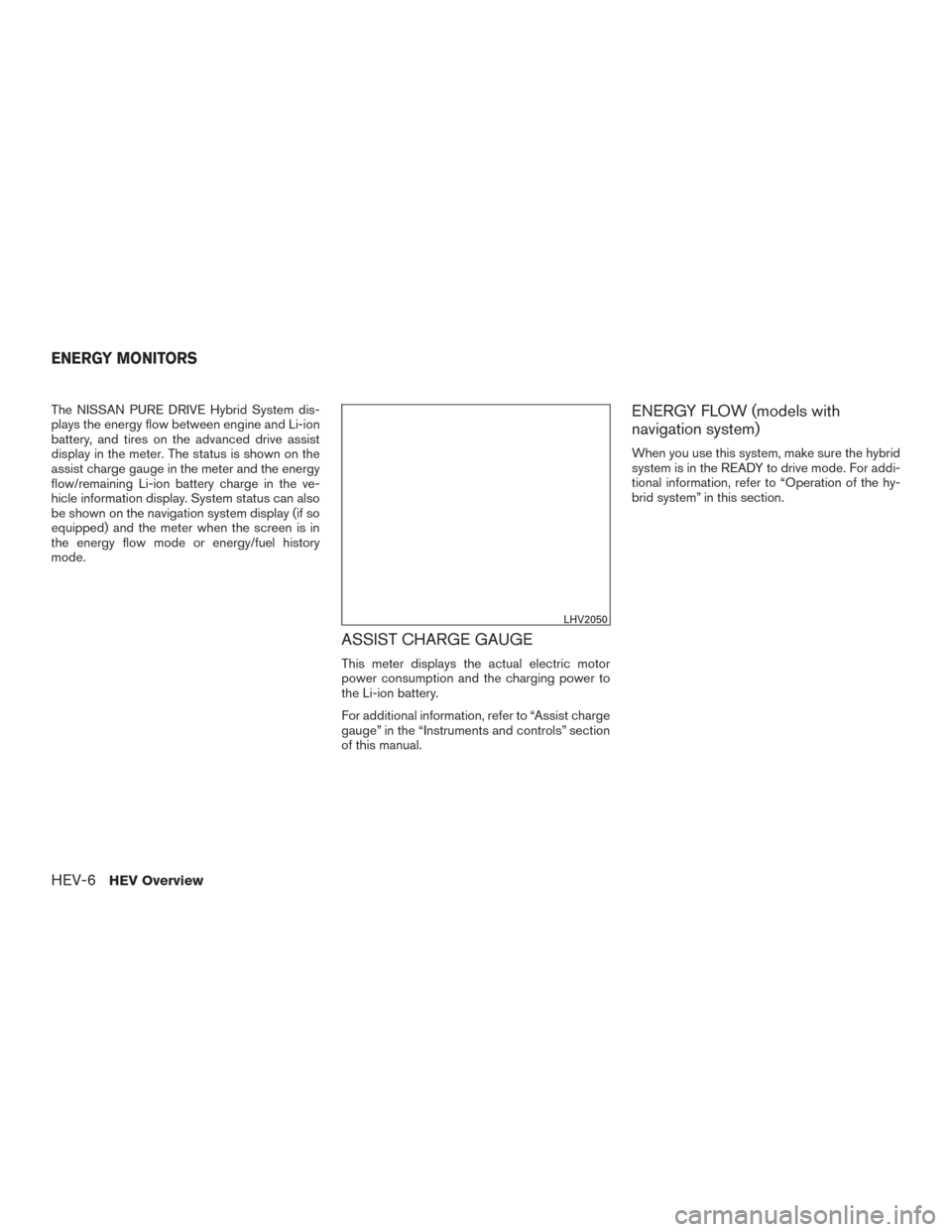
The NISSAN PURE DRIVE Hybrid System dis-
plays the energy flow between engine and Li-ion
battery, and tires on the advanced drive assist
display in the meter. The status is shown on the
assist charge gauge in the meter and the energy
flow/remaining Li-ion battery charge in the ve-
hicle information display. System status can also
be shown on the navigation system display (if so
equipped) and the meter when the screen is in
the energy flow mode or energy/fuel history
mode.
ASSIST CHARGE GAUGE
This meter displays the actual electric motor
power consumption and the charging power to
the Li-ion battery.
For additional information, refer to “Assist charge
gauge” in the “Instruments and controls” section
of this manual.
ENERGY FLOW (models with
navigation system)
When you use this system, make sure the hybrid
system is in the READY to drive mode. For addi-
tional information, refer to “Operation of the hy-
brid system” in this section.
LHV2050
ENERGY MONITORS
HEV-6HEV Overview
Page 18 of 520
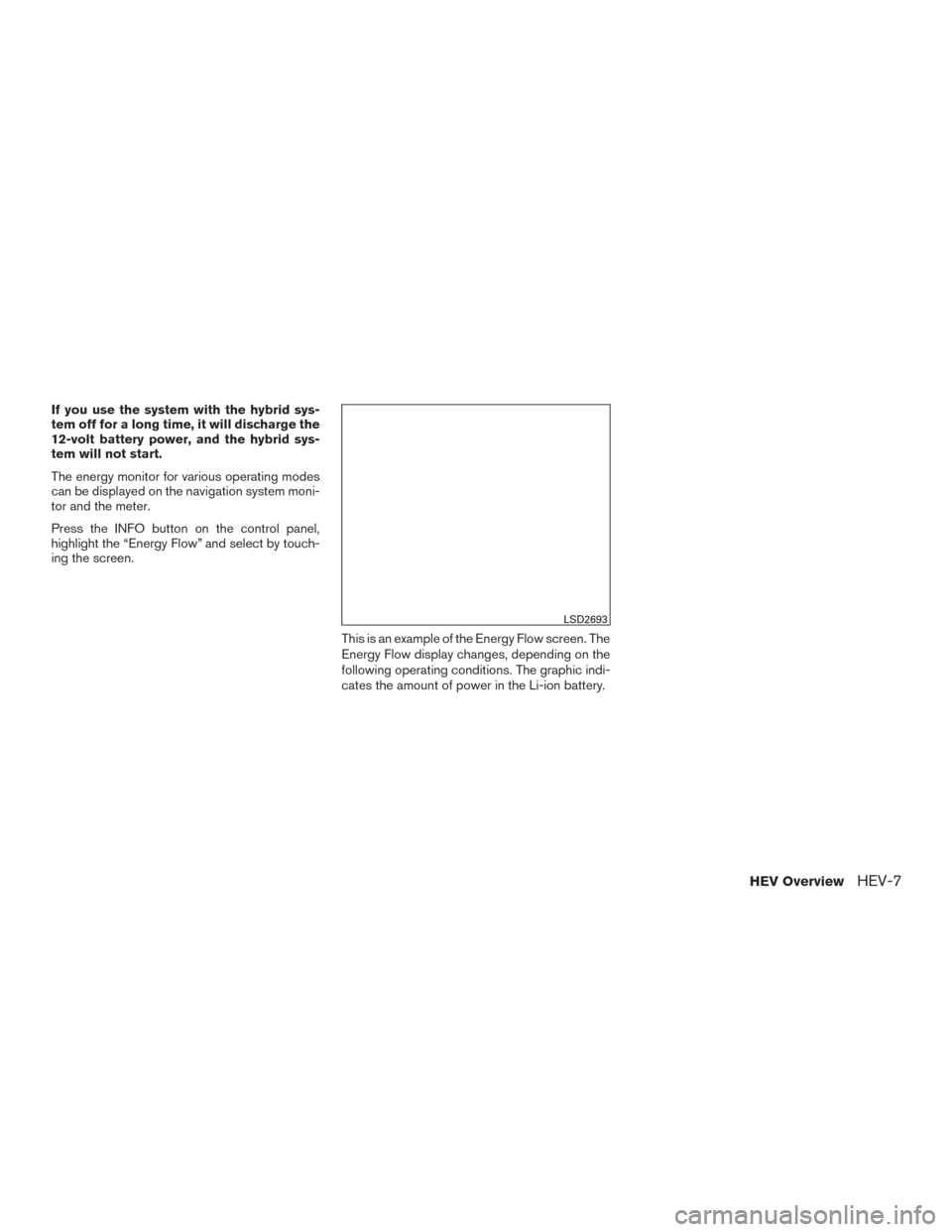
If you use the system with the hybrid sys-
tem off for a long time, it will discharge the
12-volt battery power, and the hybrid sys-
tem will not start.
The energy monitor for various operating modes
can be displayed on the navigation system moni-
tor and the meter.
Press the INFO button on the control panel,
highlight the “Energy Flow” and select by touch-
ing the screen.This is an example of the Energy Flow screen. The
Energy Flow display changes, depending on the
following operating conditions. The graphic indi-
cates the amount of power in the Li-ion battery.
LSD2693
HEV OverviewHEV-7
Page 20 of 520
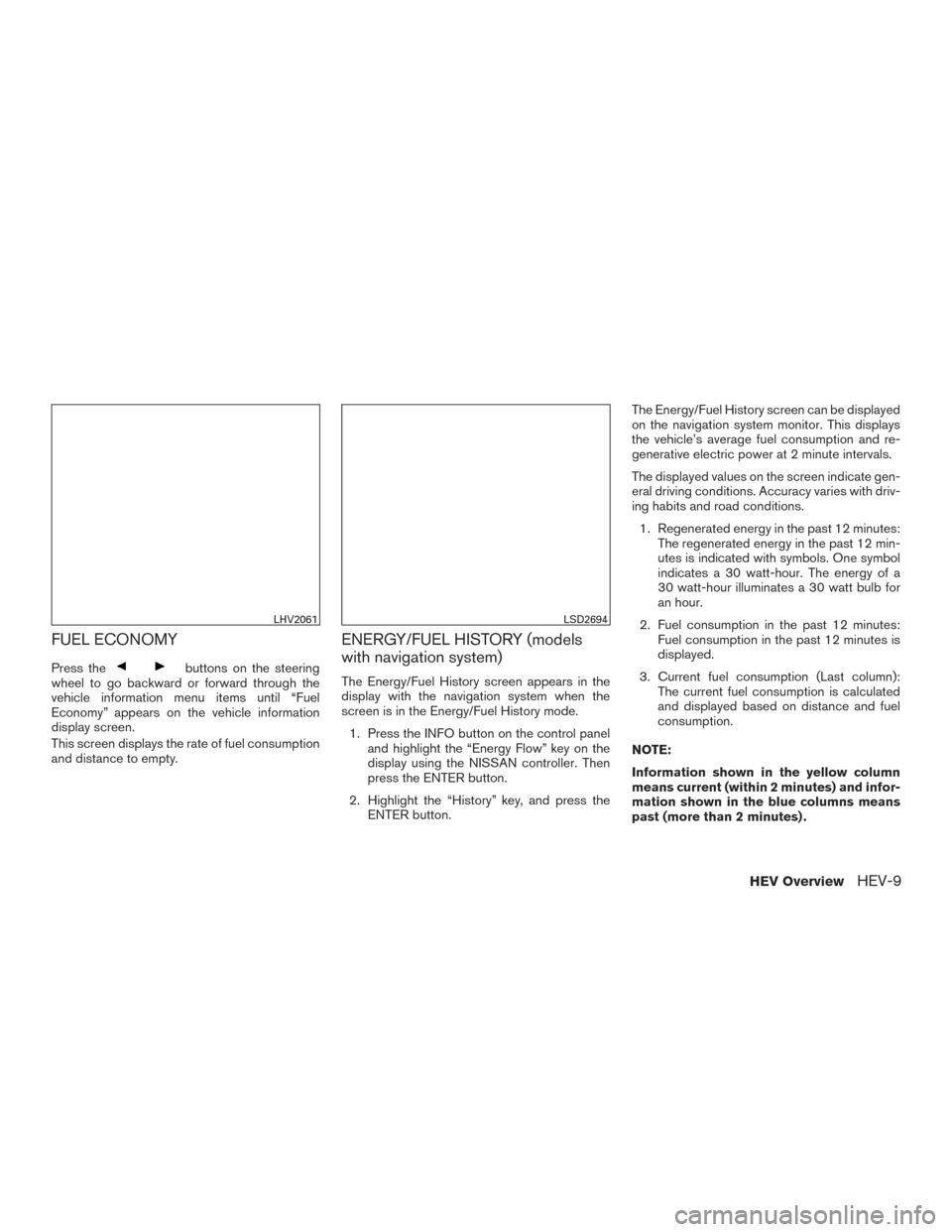
FUEL ECONOMY
Press thebuttons on the steering
wheel to go backward or forward through the
vehicle information menu items until “Fuel
Economy” appears on the vehicle information
display screen.
This screen displays the rate of fuel consumption
and distance to empty.
ENERGY/FUEL HISTORY (models
with navigation system)
The Energy/Fuel History screen appears in the
display with the navigation system when the
screen is in the Energy/Fuel History mode.
1. Press the INFO button on the control panel and highlight the “Energy Flow” key on the
display using the NISSAN controller. Then
press the ENTER button.
2. Highlight the “History” key, and press the ENTER button. The Energy/Fuel History screen can be displayed
on the navigation system monitor. This displays
the vehicle’s average fuel consumption and re-
generative electric power at 2 minute intervals.
The displayed values on the screen indicate gen-
eral driving conditions. Accuracy varies with driv-
ing habits and road conditions.
1. Regenerated energy in the past 12 minutes: The regenerated energy in the past 12 min-
utes is indicated with symbols. One symbol
indicates a 30 watt-hour. The energy of a
30 watt-hour illuminates a 30 watt bulb for
an hour.
2. Fuel consumption in the past 12 minutes: Fuel consumption in the past 12 minutes is
displayed.
3. Current fuel consumption (Last column): The current fuel consumption is calculated
and displayed based on distance and fuel
consumption.
NOTE:
Information shown in the yellow column
means current (within 2 minutes) and infor-
mation shown in the blue columns means
past (more than 2 minutes) .
LHV2061LSD2694
HEV OverviewHEV-9
Page 21 of 520
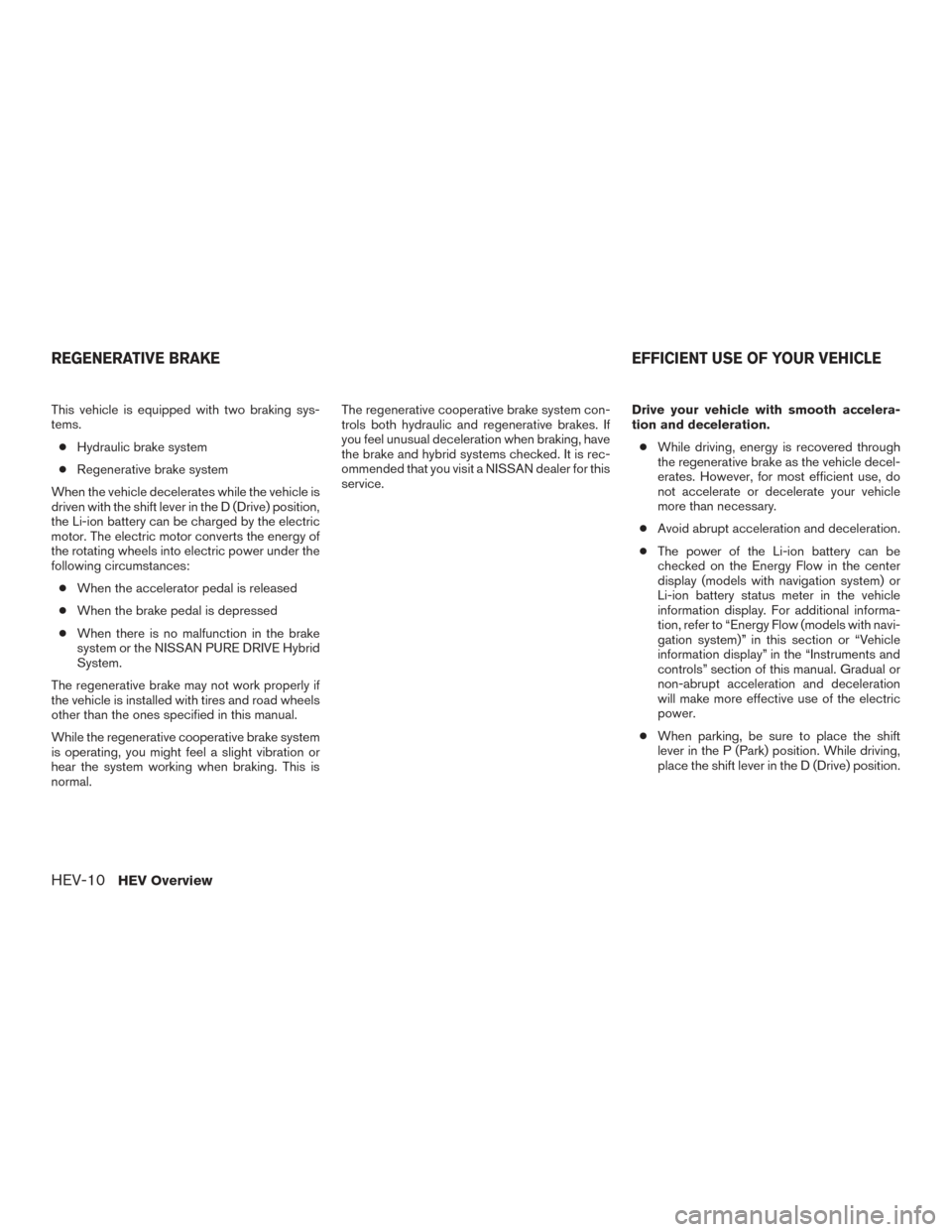
This vehicle is equipped with two braking sys-
tems.● Hydraulic brake system
● Regenerative brake system
When the vehicle decelerates while the vehicle is
driven with the shift lever in the D (Drive) position,
the Li-ion battery can be charged by the electric
motor. The electric motor converts the energy of
the rotating wheels into electric power under the
following circumstances: ● When the accelerator pedal is released
● When the brake pedal is depressed
● When there is no malfunction in the brake
system or the NISSAN PURE DRIVE Hybrid
System.
The regenerative brake may not work properly if
the vehicle is installed with tires and road wheels
other than the ones specified in this manual.
While the regenerative cooperative brake system
is operating, you might feel a slight vibration or
hear the system working when braking. This is
normal. The regenerative cooperative brake system con-
trols both hydraulic and regenerative brakes. If
you feel unusual deceleration when braking, have
the brake and hybrid systems checked. It is rec-
ommended that you visit a NISSAN dealer for this
service.
Drive your vehicle with smooth accelera-
tion and deceleration.
● While driving, energy is recovered through
the regenerative brake as the vehicle decel-
erates. However, for most efficient use, do
not accelerate or decelerate your vehicle
more than necessary.
● Avoid abrupt acceleration and deceleration.
● The power of the Li-ion battery can be
checked on the Energy Flow in the center
display (models with navigation system) or
Li-ion battery status meter in the vehicle
information display. For additional informa-
tion, refer to “Energy Flow (models with navi-
gation system)” in this section or “Vehicle
information display” in the “Instruments and
controls” section of this manual. Gradual or
non-abrupt acceleration and deceleration
will make more effective use of the electric
power.
● When parking, be sure to place the shift
lever in the P (Park) position. While driving,
place the shift lever in the D (Drive) position.
REGENERATIVE BRAKE EFFICIENT USE OF YOUR VEHICLE
HEV-10HEV Overview
Page 33 of 520
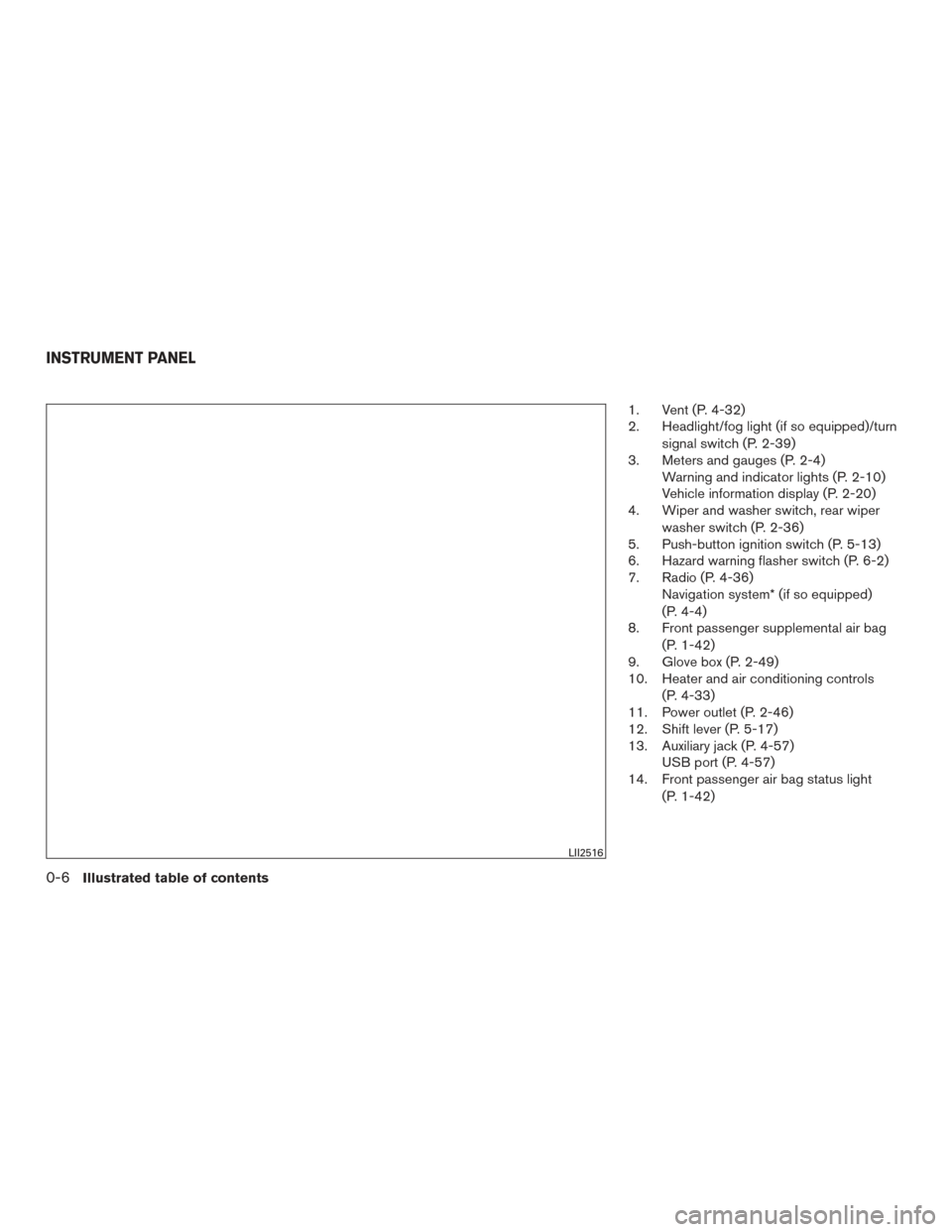
1. Vent (P. 4-32)
2. Headlight/fog light (if so equipped)/turnsignal switch (P. 2-39)
3. Meters and gauges (P. 2-4) Warning and indicator lights (P. 2-10)
Vehicle information display (P. 2-20)
4. Wiper and washer switch, rear wiper
washer switch (P. 2-36)
5. Push-button ignition switch (P. 5-13)
6. Hazard warning flasher switch (P. 6-2)
7. Radio (P. 4-36) Navigation system* (if so equipped)
(P. 4-4)
8. Front passenger supplemental air bag
(P. 1-42)
9. Glove box (P. 2-49)
10. Heater and air conditioning controls
(P. 4-33)
11. Power outlet (P. 2-46)
12. Shift lever (P. 5-17)
13. Auxiliary jack (P. 4-57) USB port (P. 4-57)
14. Front passenger air bag status light
(P. 1-42)
LII2516
INSTRUMENT PANEL
0-6Illustrated table of contents
Page 34 of 520
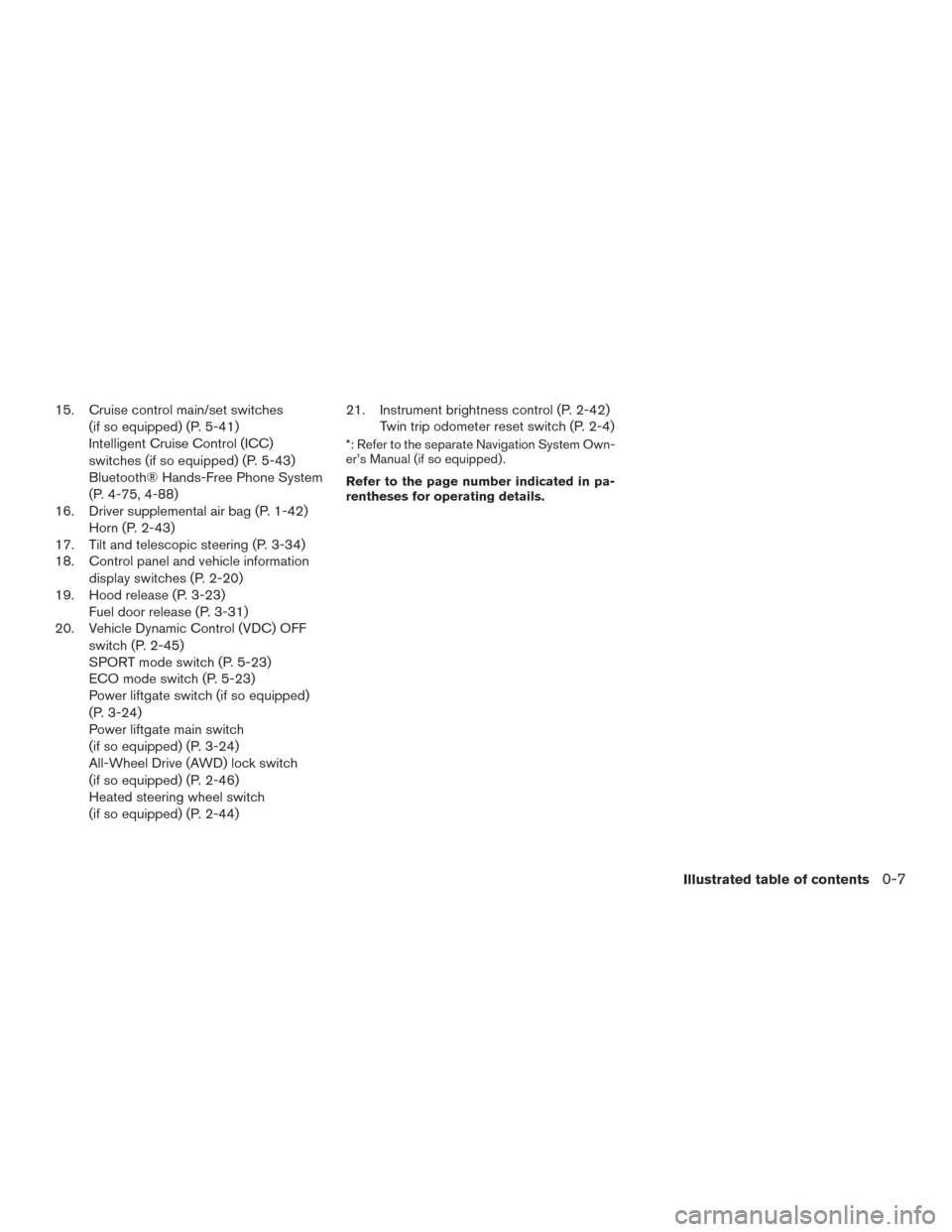
15. Cruise control main/set switches(if so equipped) (P. 5-41)
Intelligent Cruise Control (ICC)
switches (if so equipped) (P. 5-43)
Bluetooth® Hands-Free Phone System
(P. 4-75, 4-88)
16. Driver supplemental air bag (P. 1-42) Horn (P. 2-43)
17. Tilt and telescopic steering (P. 3-34)
18. Control panel and vehicle information
display switches (P. 2-20)
19. Hood release (P. 3-23) Fuel door release (P. 3-31)
20. Vehicle Dynamic Control (VDC) OFF
switch (P. 2-45)
SPORT mode switch (P. 5-23)
ECO mode switch (P. 5-23)
Power liftgate switch (if so equipped)
(P. 3-24)
Power liftgate main switch
(if so equipped) (P. 3-24)
All-Wheel Drive (AWD) lock switch
(if so equipped) (P. 2-46)
Heated steering wheel switch
(if so equipped) (P. 2-44) 21. Instrument brightness control (P. 2-42)
Twin trip odometer reset switch (P. 2-4)
*: Refer to the separate Navigation System Own-
er’s Manual (if so equipped) .
Refer to the page number indicated in pa-
rentheses for operating details.
Illustrated table of contents0-7